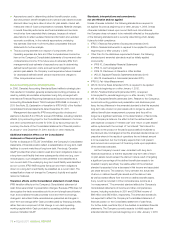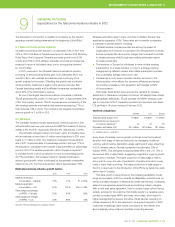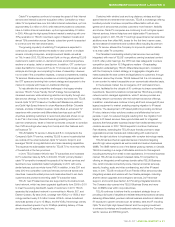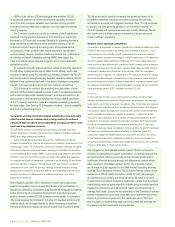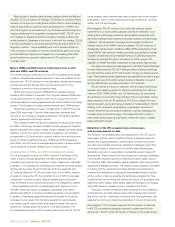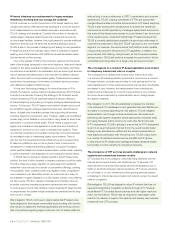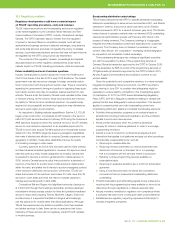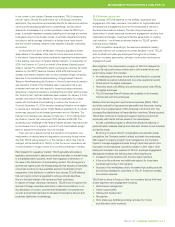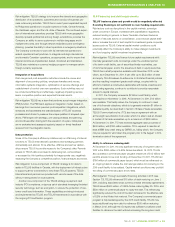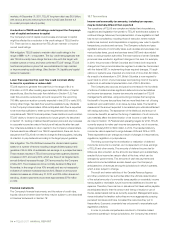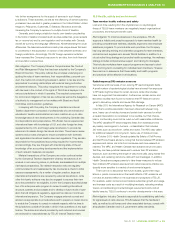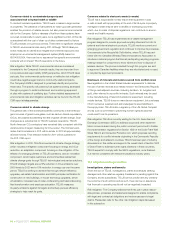Telus 2011 Annual Report Download - page 92
Download and view the complete annual report
Please find page 92 of the 2011 Telus annual report below. You can navigate through the pages in the report by either clicking on the pages listed below, or by using the keyword search tool below to find specific information within the annual report.
88 . TELUS 2011 ANNUAL REPORT
IP-based telephony as a replacement for legacy analogue
telephony is evolving and cost savings are uncertain
TELUS continues to monitor the evolution of IP-based telephony tech-
nologies and service offerings and has developed a consumer solution
for IP-based telephony over broadband access in accordance with
TELUS’ strategy and standards. Currently this solution is intended to
replace legacy analogue telephone service in areas that are served
by fibre-based facilities. However, this could expand to provide additional
telephone services over the same line as existing analogue service.
TELUS is also in the process of designing and testing its next-generation
IP telephony solution for business users, which is intended to replace
existing, end-of-life business VoIP platforms as well as address areas
that are served via fibre access.
One of the realities of VoIP in the consumer space is that the actual
state of technology developed to inter-work telephony, video and Internet
access on the same broadband infrastructure is in its infancy and there
are risks and uncertainties to be addressed, such as ensuring all services
can be delivered simultaneously to the home (and to different devices
within the home) with uncompromised quality. These issues are exacer-
bated when the exchange of information is between service providers
with different broadband infrastructures.
A long-term technology strategy is to move all services to IP to
simplify the network, reduce costs and enable advanced TELUS Future
Friendly Home services. Pursuing this strategy to its full extent would
involve transitioning TELUS’ standard telephone service offering to
IP-based telephony and phasing out legacy analogue-based telephone
service. To this point, TELUS’ legacy voice network infrastructure could
be simplified if regular analogue telephone lines were discontinued in
favour of digital-only broadband access lines supporting all services
including telephony, Internet and video. However, digital-only broadband
access may not be feasible or economical in many areas for some time,
particularly in rural and remote areas. TELUS needs to support both
legacy and broadband voice systems for some time and, therefore, is
expected to continue to incur costs to maintain both systems. There
is a risk that investments in broadband voice may not be accompanied
by decreased costs of maintaining legacy voice systems. There is
also the risk that broadband access infrastructure and corresponding
IP-telephony platforms may not be in place in time to avoid some
reinvestment in traditional switching platforms to support the legacy
public switched telephone network access base in certain areas, resulting
in some investment in line adaptation in non-broadband central offices.
If TELUS were to decide to migrate towards a fully IP-based voice
solution, the level of effort required to migrate customers could be costly.
TELUS is observing a large migration of users away from traditional
residential voice services onto cellular or competitive offerings, creating
the possibility, when combined with long migration times, of significant
over-investment in an alternative solution for customers who may not
be available to migrate. Migration to a DSL-based, primary voice offering
will also require TELUS to develop a strategy around battery back-up,
proactive customer premises equipment replacement and increased
in-home support (truck rolls). Similarly, hosted business IP telephony has
not experienced the uptake industry analysts had predicted and its long-
term future is unclear.
Risk mitigation: TELUS continues to deploy residential IP-based voice
technologies into fibre-based communities and is working with vendors
and industry to assess the technical applicability and evolving cost pro-
files of proactively migrating legacy customers onto IP-based platforms
while striving to ensure adherence to CRTC commitments and customer
expectations. TELUS’ ongoing investments in FTTN and access tech-
nologies should enable a smoother future evolution of IP-based telephony.
TELUS is also working with manufacturers to optimize the operations,
cost structure and life expectancy of analogue systems and solutions so
that some of this infrastructure evolves to a point where it can form a part
of the overall evolution towards IP. Additionally, IP-based solutions that
TELUS is currently deploying are capable of supporting a wide range of
customers and services to help limit TELUS’ exposure to any one market
segment. For example, the new business VoIP platform is also capable
of supporting consumer services and OTT capabilities, in addition to a
pure business VoIP offering. Going forward, as the Company’s wireless
services evolve, TELUS will continue to assess the opportunity to further
consolidate technology silos into a single voice service environment.
The convergence in a common IP-based application environment
for telephony, Internet and video is complex
The convergence of wireless and wireline voice, Internet and video
in a common IP-based application environment, carried over a common
IP-based network, provides opportunities for cost savings and for the
rapid development of more advanced services that are also more flexible
and easier to use. However, the transformation from individual silo
systems and architectures to a common environment is very complex
and could be accompanied by implementation errors, design issues
and system instability.
Risk mitigation: In 2011, TELUS substantially completed the transition
of its previous IP TV middleware to next generation Microsoft Mediaroom
and plans to continue expanding the new platform. TELUS mitigates
implementation risk through modular architectures, lab investments,
part nering with system integrators where appropriate, employee trials,
and using hardware that is common to most other North American
IP TV deployments. TELUS is striving to ensure that its IP TV deployment
is part of an open framework that will fit into the overall transformation
strategy once standards are ratified and the actual implementations
have stabilized, particularly with the set-top box. TELUS is also active
in a number of standards bodies such as the MEF and IP Sphere
to help ensure its IP infrastructure strategy leverages standards-based
functionality to further simplify the Company’s networks.
The emergence of OTT services presents challenges to network
capacity and conventional business models
OTT services are a new category of services being delivered over the
Internet and compete directly with traditional pay-TV services. OTT
video services in particular have rapidly become the largest source of
traffic on the North American Internet backbone. OTT service providers
do not invest in, or own, networks and their growing services present
a chal lenge to Internet service providers and network owners to prevent
network congestion.
Risk mitigation: TELUS has designed a robust IP network that has not
experienced significant congestion problems through 2011. However,
as additional OTT providers launch services and offer higher resolution
video over the Internet, TELUS may be required to make larger invest-
ments in the network to support this capacity and develop new business
models with the OTT providers.


